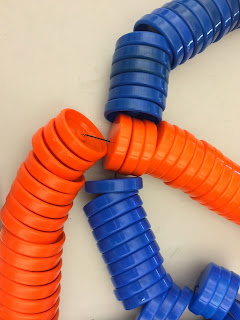Blog Deliverable #3
1. Triangle Insert Parameter Process Sheet
The parameters for the triangle insert were improved through the trial and error of runs. We started with values close to what we deemed were plausible to produce a quality part. With each run, certain parameters were changed in order to create a better product. We came away with values of 8 seconds and 20 seconds for the holding time and cooling time, respectively. The screw feed stroke was set to 2 inches while the screw feed delay time was 0 seconds or not necessary. The injection speed profile from V12-V21 ranged from .2 to 3.5 with an injection pressure of 1101 PSI. The injection pressure was chosen in order to ensure full packing of the mold and to make sure no vacuum voids would form during the cooling period. The injection pressure also allows for the mold to be completely filled with plastic while not allowing flash along the outer edges of the part. The ejector counter was set at 2 and the ejector pin lengths were 5.647 and eight of them were used.
2. Process Optimization
The process optimization labs allowed the Aperture Science team to work on fixing molds and production processes in order to produce a quality Yo-Yo. Through this work, several part and mold redesigns were found to be necessary to improve our product. We had to remachine the triangle spider because a defect was created in the mold from where a tool broke while machining the mold. However, no dimensions were changed from the previous mold. The triangle insert involved the most rework. A new cavity mold was machined for the triangle insert. The triangles were made higher and larger so the part would cool better and more uniformly. This also helped with reducing the void in the corners of the triangles on the underside. A ten degree draft angle was added to the triangle as well. This made the part easier to remove from the mold, reducing its chance to stick to the mold. The inside of the triangle mold was sanded as well, in order to eliminate machine lines. The string gap was also changed. Our original specification for the string gap was set at .25 inches. This was a rough estimate without any reference. When it came time to machine shafts for the body of the yo-yos, we realized this initial guess was far off from an acceptable dimension especially since our mold thickness was .25 inches. Our string gap was reduced to .075 inches. Much like the numbers for the triangle insert, the other parts were run and our group selected appropriate values for the speeds and pressures in order to create the best part we could. Through our groups testing, we came away with a completed optimized working yo-yo which spins around 3350 RPM.
Here is a picture of Kyle working hard optimizing the body of the Aperture Science Yo-Yo:
Below is a video of Ben playing with a completed Aperture Science Yo-Yo.
Below are the process parameter sheets for each part of the Aperture Science Yo-Yo. These include both thermoforming and injection molding parts. The triangle insert is located up above in part 1 of the deliverable.











No comments:
Post a Comment